


Latest News
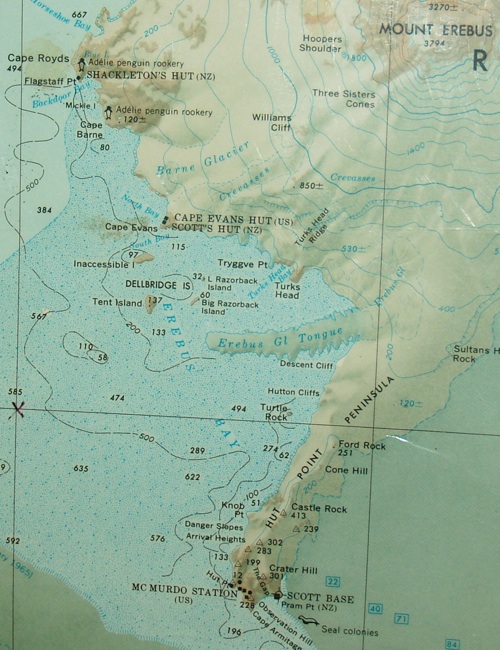
Team arrives at Scott Base Antarctica
“I am just going outside and may be some time.”
These were the last words of Captain Lawrence Oates when, suffering ever worsening frostbite and malnourishment on Captain Robert Scott’s fateful 1912 expedition to the South Pole, he walked out of the tent and into a blizzard at -40˚ C toward certain death. He was never seen again.
Oates’ death was viewed at the time as a heroic act of self-sacrifice, releasing Scott and the others from the burden of Oates’ ill-health, which was compromising the party’s chances of survival. Scott and his companions were in dire straits, struggling back toward their base camp on the Antarctic coast after discovering they had lost the race to the South Pole to the Norwegian explorer Roald Amundsen. Nine days after Scott recorded Oates’ last word, he and his remaining companions were also dead.
On October 17 the Antarctica 2010 research team, including Craig Stevens, Alexander Forrest, Martin Doble, Brett Grant and Andrew Hamilton arrived in Christchurch and visited the memorial to Captain Robert Scott. We can admire the efforts these men put forth in exploring the ends of the earth, but more importantly we can learn something from their successes and failures. On his quest for the pole Amundsen had covered great distances in short time using a combination of dog sleds and skis, while Scott had laboured by horse and foot, perhaps poor modes of transport over an ice cap, potentially contributing to his eventual demise. The extreme nature of Antarctica can mean mistakes are very costly, and adapting to the environment is necessary for safety and success of even modern scientific expeditions.
To be able to work in the cold conditions of spring-time in Antarctica, our field team spent the afternoon getting outfitted with cold weather gear at the Antarctica New Zealand logistics base here in Christchurch. Each researcher was kitted-out with thermal long johns, fleece jackets, snowmobile pants, insulated wind breakers, a down parka, gloves, mitts, hats, googles and winter boots rated to -100˚ C. While this may sound like standard clothing found in most Canadian closets, the New Zealand gear is top notch and they run a very efficient operation. The hazards of working in Antarctica are real, weather can change in minutes, so every step is taken to ensure the safety of all personnel. Quite literally you can arrive at the AntarcticaNZ logistics base in jeans and a t-shirt and leave ready for a -40˚ C blizzard on the ice cap!
The following morning Craig, Alexander, Martin and Brett boarded a US Air Force plane headed to the New Zealand operated Scott Base. They were joined by about 50 other American personnel headed to the American operated McMurdo Base, just a few kilometres away. The direct flight from Christchurch to the landing strip on the sea ice in McMurdo Sound is approximately 5 hours, covering 34˚ of latitude heading due south. Unexpected fog or blizzard conditions in Antarctica can mean the aircraft is unable to land on the sea ice runway and must turn back to Christchurch, turning a 5 hour trip into a 10 hour trip, and another attempt made on the next clear weather window. Flights have been known to be weather delayed for up to a week. This delay seems like a fairly minor inconvenience considering the effort early explorers put into mounting expeditions to the very same location a hundred years ago: this could involve sailing through the monstrous waves and ferocious winds of the Southern Ocean, breaking through miles of pack ice capable of crushing even the strongest vessel, setting up a base camp on a remote barren rock, then overwintering in the bitter cold and darkness, only to struggle through blizzards across unexplored terrain the following year aiming for an abstract point about which the planet rotates.
Despite our modern technologies and safety nets, in Antarctica Mother Nature still rules supreme, and all expeditions are subject to her whims. Luckily, at about 8pm local time last night I received a call from Craig letting me know that they had arrived safely in balmy -20˚ C weather and all was well. Perhaps inspired by Amundsen’s example for a successful expedition, word has it that Alexander was off on a quick ski tour within a couple hours of arrival at Scott Base.
The team has sorted through the scientific gear and has successfully setup the AUV and the ROV and run through a few initial system tests - everything is functioning properly. Likely on Oct 21st they will head out to the field site by snowmobile, an hour ride away, and spend a few days setting up camp and drilling ice holes for the scientific instruments. The camp, consisting of heated shipping containers and a polar haven tent, will be set up right beside the tip of the Erebus Glacier Tongue, with Mount Erebus looming in the background. Once the camp is setup the instruments, including the AUV and ROV, get dipped in the cold water for the first time. Then the real fun begins!
Stay tuned for the next newsletter that hopefully, if all goes well, will include an update on data collection under the ice. I don’t expect the team will encounter the terrible conditions of Scott and his men, but we can wish them the best of luck anyway!
All the best from trembling Christchurch (we had a brief 5.0 aftershock here yesterday, rattled the dishes around a bit, but all was well otherwise).
Cheers
Andrew
Monday, October 18, 2010
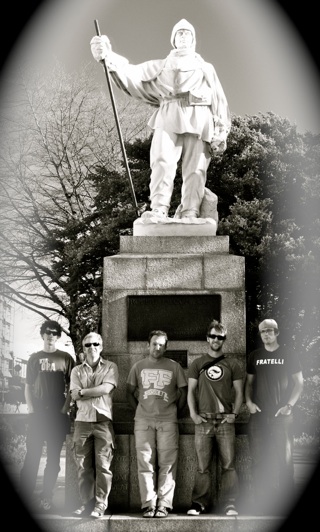
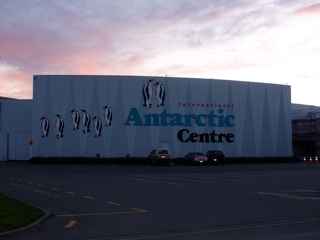
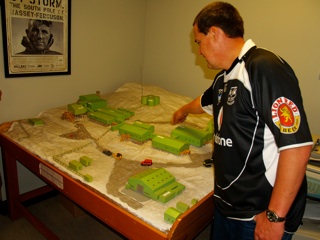
Antarctica 2010 Team at the Captain Robert Falcon Scott Memorial in Christchurch, NZ. From left - Brett Grant, Craig Stevens, Martin Doble, Andrew Hamilton, and Alexander Forrest. © A. Hamilton
The International Antarctic Centre, an educational and interactive exhibit on all things related to the Big Ice. Apparently includes a walk-in freezer with a fan that simulates an Antarctic blizzard! © A. Hamilton
Antarctica New Zealand logistics manager Paul Woodgate points out the organization of Scott Base on a scale model while a poster of another famous Kiwi, Sir Edmond Hilary, looks on. © A. Hamilton
Map showing the area the field team is heading. At bottom are Scott Base and McMurdo Base on a peninsula of Ross Island that separates the Ross Ice Shelf (green) from the sea ice of McMurdo Sound (blue). The Erebus Glacier Tongue extends from the slope of Mount Erebus, with the huts of Shackleton and Scott nearby. © A. Hamilton
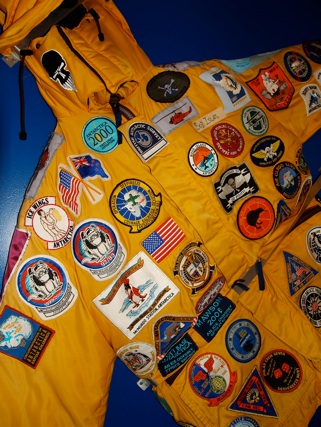
A US Antarctica program personnel’s parka on display at the International Antarctic Centre, sporting patches from decades of projects. I wonder what scientific question the ‘Ice Wings Antarctica ‘ project was investigating? Hmmm....© A. Hamilton
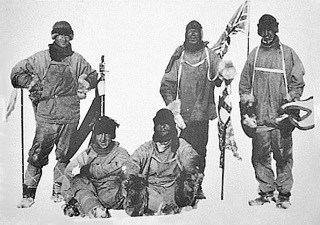
Scott’s South Pole Team 1912: Wilson, Scott and Oates (standing); and Bowers and Evans (sitting). Credit: Henry Bowers, Source: Wikipedia.